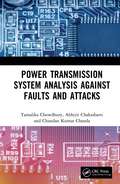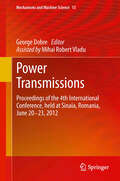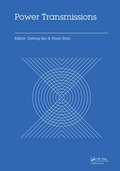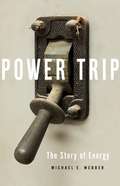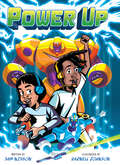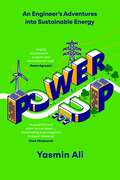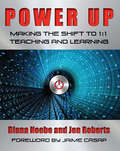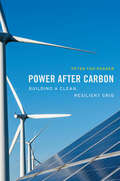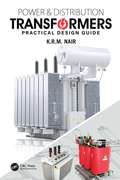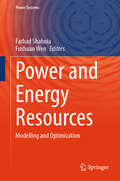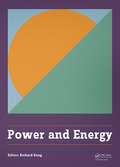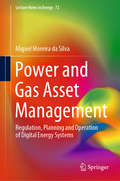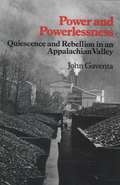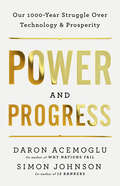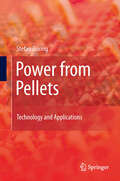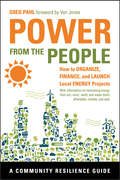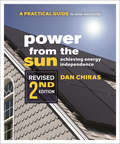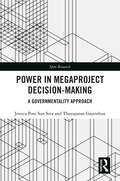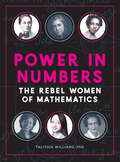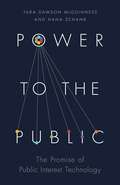- Table View
- List View
Power Transmission System Analysis Against Faults and Attacks
by Abhijit Chakrabarti Chandan Kumar Chanda Tamalika ChowdhuryThe present-day power grid is basically a complex power transmission network with risks of failure due to unplanned attacks and contingencies, and therefore, assessment of vulnerability of transmission network is important and the process is based on contingency approach. This book deals with the methods of assessment of the grid network vulnerability and addresses the grid collapse problem due to cascaded failures of the transmission network following an attack or an unplanned contingency. Basic mitigation aspects for the network has been explored and the immunity of such a power transmission network against vulnerable collapse has been described using mathematical models.
Power Transmissions: Proceedings of the 4th International Conference, held at Sinaia, Romania, June 20 -23, 2012
by George Dobre Mihai Robert VladuThis books contains the Proceedings of the 4th International Conference on Power Transmissions, that was held in Sinaia, Romania from June 20 -23, 2012. Power Transmissions is a very complex and multi-disciplinary scientific field of Mechanical Engineering that covers the different types of transmissions (mechanical, hydraulic, pneumatic) as well as all the machine elements involved, such as gears, bearings, shafts, couplings and a lot more. It concerns not only their basic theory but also their design, analysis, testing, application and maintenance. The requirements set to modern power transmissions are really tough to meet: They need to be more efficient, stronger, smaller, noiseless, easier to produce and to cost less. There is a strong demand to become easier in operation and maintenance, or even automatic and in maintenance-free. Last but not least, they should be easily recycled and respect the environment. Joint efforts of specialists from both academia and industry can significantly contribute to fulfill these needs. The main goal of this conference was to bring together experts from all over the world and present the latest developments in the field of Power Transmissions.
Power Transmissions: Proceedings of the International Conference on Power Transmissions 2016 (ICPT 2016), Chongqing, P.R. China, 27-30 October 2016
by Datong Qin & Yimin ShaoThis book presents papers from the International Conference on Power Transmissions 2016, held in Chongqing, China, 27th-30th October 2016. The main objective of this conference is to provide a forum for the most recent advances, addressing the challenges in modern mechanical transmissions. The conference proceedings address all aspects of gear and power transmission technology and a range of applications. The presented papers are catalogued into three main tracks, including design, simulation and testing, materials and manufacturing, and industrial applications. The design, simulation and testing track covers topics such as new methods and designs for all types of transmissions, modelling and simulation of power transmissions, strength, fatigue, dynamics and reliability of power transmissions, lubrication and sealing technologies and theories, and fault diagnosis of power transmissions. In the materials and manufacturing track, topics include new materials and heat treatment of power transmissions, new manufacturing technologies of power transmissions, improved tools to predict future demands on production systems, new technologies for ecologically sustainable productions and those which preserve natural resources, and measuring technologies of power transmissions. The proceedings also cover the novel industrial applications of power transmissions in marine, aerospace and railway contexts, wind turbines, the automotive industry, construction machinery, and robots.
Power Trip: The Story of Energy
by Michael E. WebberA global tour of energy--the builder of human civilization and also its greatest threat.Energy is humanity's single most important resource. In fact, as energy expert Michael E. Webber argues in Power Trip, the story of how societies rise can be told largely as the story of how they manage energy sources through time. In 2019, as we face down growing demand for and accumulating environmental impacts from energy, we are at a crossroads and the stakes are high. But history shows us that energy's great value is that it allows societies to reinvent themselves. Power Trip explores how energy has transformed societies of the past and offers wisdom for today's looming energy crisis. There is no magic bullet; energy advances always come with costs. Scientific innovation needs public support. Energy initiatives need to be tailored to individual societies. We must look for long-term solutions. Our current energy crisis is real, but it is solvable. We have the power.
Power Up (A Power Up Graphic Novel)
by Sam NissonThis inventive graphic novel that unfolds online and IRL takes readers from the halls of middle school, to epic robot video game battles, and back again. Miles and Rhys know each other only as Gryphon and Backslash, and in the video game Mecha Melee they&’re an unstoppable team. They&’re the best friends they&’ve got, online or in the real world, and they don&’t even realize they go to the same middle school. But real-life wrongdoing blasts their duo into a crater the size of Arcticon. With life online and off a complete mess and BattleCon—and the Every Game Ever tournament—just weeks away, can the boys play their way back to each other?
Power Up: An Engineer's Adventures into Sustainable Energy
by Yasmin Ali'A stimulating and affable overview of how major feats of engineering can help the world beat the climate crisis'NEW STATESMAN'A powerful and often lyrical book ... Fascinating and insightful in equal measure'MARK MIODOWNIK'Ali's enthusiasm for energy infrastructure electrifies this engaging tour of the people and structures that power our modern world'GAIA VINCE'Highly recommend ... a warm and educational read'ROMA AGRAWAL__________We rarely think about the energy systems that prop up our existence. With hot water, lighting and digital entertainment all available at the flick of a switch, it's easy to underestimate the vast global network that makes these things possible.Growing up in Iraq, Yasmin Ali regularly experienced power cuts - ironic for a country rich in oil and sunshine. Now as an engineer working in energy, Yasmin has a deep appreciation for what these resources mean for our lives. In Power Up she takes us on a journey across the globe to reveal the bigger picture, from solar farms shimmering in the desert to power stations hidden deep in the mountains. We discover where we get energy from, how it is moved and used around the world - and why we need to understand the whole system if we want to transition towards a clean, green future.Power Up is a definitive picture of the intricate world that humanity has built, and a rallying cry to face the challenges of climate change using the power at our fingertips.
Power Up: An Engineer's Adventures into Sustainable Energy
by Yasmin Ali'A stimulating and affable overview of how major feats of engineering can help the world beat the climate crisis'NEW STATESMAN'A powerful and often lyrical book ... Fascinating and insightful in equal measure'MARK MIODOWNIK'Ali's enthusiasm for energy infrastructure electrifies this engaging tour of the people and structures that power our modern world'GAIA VINCE'Highly recommend ... a warm and educational read'ROMA AGRAWAL__________We rarely think about the energy systems that prop up our existence. With hot water, lighting and digital entertainment all available at the flick of a switch, it's easy to underestimate the vast global network that makes these things possible.Growing up in Iraq, Yasmin Ali regularly experienced power cuts - ironic for a country rich in oil and sunshine. Now as an engineer working in energy, Yasmin has a deep appreciation for what these resources mean for our lives. In Power Up she takes us on a journey across the globe to reveal the bigger picture, from solar farms shimmering in the desert to power stations hidden deep in the mountains. We discover where we get energy from, how it is moved and used around the world - and why we need to understand the whole system if we want to transition towards a clean, green future.Power Up is a definitive picture of the intricate world that humanity has built, and a rallying cry to face the challenges of climate change using the power at our fingertips.
Power Up: An Engineer's Adventures into Sustainable Energy
by Yasmin Ali'A stimulating and affable overview of how major feats of engineering can help the world beat the climate crisis'NEW STATESMAN'A powerful and often lyrical book ... Fascinating and insightful in equal measure'MARK MIODOWNIK'Ali's enthusiasm for energy infrastructure electrifies this engaging tour of the people and structures that power our modern world'GAIA VINCE'Highly recommend ... a warm and educational read'ROMA AGRAWAL__________We rarely think about the energy systems that prop up our existence. With hot water, lighting and digital entertainment all available at the flick of a switch, it's easy to underestimate the vast global network that makes these things possible.Growing up in Iraq, Yasmin Ali regularly experienced power cuts - ironic for a country rich in oil and sunshine. Now as an engineer working in energy, Yasmin has a deep appreciation for what these resources mean for our lives. In Power Up she takes us on a journey across the globe to reveal the bigger picture, from solar farms shimmering in the desert to power stations hidden deep in the mountains. We discover where we get energy from, how it is moved and used around the world - and why we need to understand the whole system if we want to transition towards a clean, green future.Power Up is a definitive picture of the intricate world that humanity has built, and a rallying cry to face the challenges of climate change using the power at our fingertips.
Power Up: Making the Shift to 1:1 Teaching and Learning
by Diana Neebe Jen RobertsWherever you are on the path to 1:1 teaching and learning, you need a guide that can help you make the best use of the powerful technology available in today's classrooms. In Power Up: Making the Shift to 1:1 Teaching and Learning, Diana Neebe and Jen Roberts draw on research and their extensive experience working with teachers across subject areas and grade levels to share the keys to success when teaching with a computer or tablet for every student. This is the book secondary teachers need to understand the changes in pedagogy, planning, classroom organization, time management, and collaboration that will help them be successful in a 1:1 environment. Whether providing immediate and detailed feedback to student writers, giving voice to quiet learners, or creating more time for actual work in a jam-packed school day, Neebe and Roberts show teachers how communication, differentiation, and other effective practices can be powered up with personalized technology. Throughout the book, Neebe and Roberts coach teachers through their initial concerns about technology integration, offer advice about avoiding common problems, and encourage innovation. Using detailed classroom examples, questions, and suggestions, they provide a framework for shaping the transformation of a traditional classroom into a student-centered, technology-rich learning environment. Readers will come away with a clear sense of how a fully implemented 1:1 classroom operates. Power Up makes the transition to 1:1 a manageable and exciting journey. It's a key part of supporting teachers and ensuring the success of your 1:1 program.
Power Vacuum Tubes Handbook (Electronics Handbook Series #16)
by Jerry WhitakerProviding examples of applications, Power Vacuum Tubes Handbook, Third Edition examines the underlying technology of each type of power vacuum tube device in common use today. The author presents basic principles, reports on new development efforts, and discusses implementation and maintenance considerations. Supporting mathematical equations and extensive technical illustrations and schematic diagrams help readers understand the material. Translate Principles into Specific Applications This one-stop reference is a hands-on guide for engineering personnel involved in the design, specification, installation, and maintenance of high-power equipment utilizing vacuum tubes. It offers a comprehensive look at the important area of high-frequency/high-power applications of microwave power devices, making it possible for general principles to be translated into specific applications. Coverage includes power grid tubes—triodes, tetrodes, and pentodes—as well as microwave power tubes such as klystrons, traveling wave tubes, gyrotrons, and other high-frequency devices. These vacuum tubes are used in applications from radio broadcasting to television, radar, satellite communications, and more. Explore a Wide Variety of Methods in Power Vacuum Tube Design This third edition includes updates on vacuum tube technology, devices, applications, design methods, and modulation methods. It also expands its scope to cover properties of materials and RF system maintenance and troubleshooting. Explaining difficult concepts and processes clearly, this handbook guides readers in the design and selection of a power vacuum tube-based system. What’s New in This Edition Includes two new chapters on properties of materials and RF system maintenance and troubleshooting Contains updates and additions in most chapters Identifies key applications for commercial and scientific research Examines the frontiers of materials science directly impacting construction, reliability, and performance Reviews methods of power tube design for more efficient, longer-lasting tubes Features updated illustrations throughout to clarify and explain fundamental principles and implementation considerations
Power after Carbon: Building a Clean, Resilient Grid
by Peter Fox-PennerAs the electric power industry faces the challenges of climate change, technological disruption, new market imperatives, and changing policies, a renowned energy expert offers a roadmap to the future of this essential sector. As the damaging and costly impacts of climate change increase, the rapid development of sustainable energy has taken on great urgency. The electricity industry has responded with necessary but wrenching shifts toward renewables, even as it faces unprecedented challenges and disruption brought on by new technologies, new competitors, and policy changes. The result is a collision course between a grid that must provide abundant, secure, flexible, and affordable power, and an industry facing enormous demands for power and rapid, systemic change. The fashionable solution is to think small: smart buildings, small-scale renewables, and locally distributed green energy. But Peter Fox-Penner makes clear that these will not be enough to meet our increasing needs for electricity. He points instead to the indispensability of large power systems, battery storage, and scalable carbon-free power technologies, along with the grids and markets that will integrate them. The electric power industry and its regulators will have to provide all of these, even as they grapple with changing business models for local electric utilities, political instability, and technological change. Power after Carbon makes sense of all the moving parts, providing actionable recommendations for anyone involved with or relying on the electric power system.
Power and Distribution Transformers: Practical Design Guide
by K.R.M. NairThis book is based on the author's 50+ years experience in the power and distribution transformer industry. The first few chapters of the book provide a step-by-step procedures of transformer design. Engineers without prior knowledge or exposure to design can follow the procedures and calculation methods to acquire reasonable proficiency necessary to designing a transformer. Although the transformer is a mature product, engineers working in the industry need to understand its fundamentals oand design to enable them to offer products to meet the challenging demands of the power system and the customer. This book can function as a useful guide for practicing engineers to undertake new designs, cost optimization, design automation etc., without the need for external help or consultancy. The book extensively covers the design processes with necessary data and calculations from a wide variety of transformers, including dry-type cast resin transformers, amorphous core transformers, earthing transformers, rectifier transformers, auto transformers, transformers for explosive atmospheres, and solid-state transformers. The other subjects covered include, carbon footprint salculation of transformers, condition monitoring of transformers and design optimization techniques. In addition to being useful for the transformer industry, this book can serve as a reference for power utility engineers, consultants, research scholars, and teaching faculty at universities.
Power and Energy Resources: Modelling and Optimization (Power Systems)
by Farhad Shahnia Fushuan WenThis book highlights recent research advancements in the area of power and energy systems. Electrical networks all around the world are experiencing the integration of various types of energy resources including energy storage systems, and these systems are forming the future of power generation and delivery systems. There has been significant research interest in this area over the past decade. Proper designing, planning and operating such systems are crucial and the key area of interest for researchers and utilities. The key emphasis of this book is on modeling, analysis, optimization and management aspects of different types of power and energy systems and assets within electrical power networks. Interesting topics such as their planning, operation and technology accommodation are also presented in detail. The chapters introduce existing and new modeling approaches, optimization, control and management methods.
Power and Energy: Proceedings of the International Conference on Power and Energy (CPE 2014), Shanghai, China, 29-30 November 2014
by Richard KongPower and Energy contains 86 selected papers from the International Conference on Power and Energy (CPE 2014, Shanghai, China, 29-30 November 2014), and presents a wide range of topics:- Energy management, planning and policy-making- Energy technologies and environment- Energy prospects- Conventional and renewable power generation- Power system man
Power and Gas Asset Management: Regulation, Planning and Operation of Digital Energy Systems (Lecture Notes in Energy #72)
by Miguel Moreira da SilvaThis book offers meaningful insights into an impending challenge for the energy industry, namely the increasing role of asset management amongst the utilities’ core operations. In the aftermath of energy digitalization, power and gas companies will be able to seize asset productivity—through risk-based operation and maintenance—and better balance capital and operational expenditures. By addressing the asset management of both power and gas infrastructures, and by adopting a comprehensive approach—including regulation and business models, as well as a solid technology background—this book offers a unique perspective on the energy utilities’ transformation journey and the road to optimal decision-making for both asset portfolio expansion and replacement. The asset management end-to-end mission requires appropriate internal governance—depending on the business framework—and the development of decision aid models (for asset replacement and maintenance), supported on probabilistic risk and reliability indexes. This book advocates systematically digitalizing the power and gas assets, addressing both data governance and infrastructure, alongside real-time equipment condition monitoring. It also provides a meaningful methodology for designing data-centric asset management and predictive operation and maintenance, using artificial intelligence and engineering-based approaches. As such, it provides valuable strategy, methods and models—illustrated by case studies and proofs of concept—for a wide range of stakeholders, including utilities and industry professionals, regulators, policy-makers, researchers and students.
Power and Powerlessness: Quiescence and Rebellion in an Appalachian Valley
by John GaventaThis book establishes that power works to develop and maintain the quiescence of the powerless; rebellion, as a corollary, may emerge as power relationships are altered and together, patterns of power and powerlessness can keep issues from arising, grievances from being voiced, and interests from being recognized.
Power and Progress: Our Thousand-Year Struggle Over Technology and Prosperity
by Simon Johnson Daron AcemogluThe bestselling co-author of Why Nations Fail and the bestselling co-author of 13 Bankers deliver a bold reinterpretation of economics and history that will fundamentally change how you see the world A thousand years of history and contemporary evidence make one thing clear: progress depends on the choices we make about technology. New ways of organizing production and communication can either serve the narrow interests of an elite or become the foundation for widespread prosperity. The wealth generated by technological improvements in agriculture during the European Middle Ages was captured by the nobility and used to build grand cathedrals, while peasants remained on the edge of starvation. The first hundred years of industrialization in England delivered stagnant incomes for working people. And throughout the world today, digital technologies and artificial intelligence undermine jobs and democracy through excessive automation, massive data collection, and intrusive surveillance. It doesn&’t have to be this way. Power and Progress demonstrates the path of technology was once—and may again—be brought under control. Cutting-edge technological advances can become empowering and democratizing tools, but not if all major decisions remain in the hands of a few hubristic tech leaders. With their bold reinterpretation of economics and history, Daron Acemoglu and Simon Johnson fundamentally change how we see the world, providing the vision needed to redirect innovation so it again benefits most people.
Power and the Vote
by Brian MinHow do developing states decide who gets access to public goods like electricity, water, and education? Power and the Vote breaks new ground by showing that the provision of seemingly universal public goods is intricately shaped by electoral priorities. In doing so, this book introduces new methods using high-resolution satellite imagery to study the distribution of electricity across and within the developing world. Combining cross-national evidence with detailed sub-national analysis and village-level data from India, Power and the Vote affirms the power of electoral incentives in shaping the distribution of public goods and challenges the view that democracy is a luxury of the rich with little relevance to the world's poor.
Power from Pellets
by Stefan DöringThis book provides a practical description of the technology of pellet production on the basis of renewable sources as well as the utilization of pellets. The author explains what kinds of biomass are usable in addition to wood, how to produce pellets and how to use pellets to produce energy. Starting with the basics of combustion, gasification and the pelletizing process, several different technologies are described. The design, planning, construction and economic efficiency are discussed as well. The appendix gives useful advice about plant concepts, calculations, addresses, conversion tables and formulas.
Power from the People: How to Organize, Finance, and Launch Local Energy Projects
by Greg Pahl"Over 90 percent of US power generation comes from large, centralized, highly polluting, nonrenewable sources of energy. It is delivered through long, brittle transmission lines, and then is squandered through inefficiency and waste. But it doesn't have to be that way. Communities can indeed produce their own local, renewable energy. Power from the People explores how homeowners, co-ops, nonprofit institutions, governments, and businesses are putting power in the hands of local communities through distributed energy programs and energy-efficiency measures. Using examples from around the nation - and occasionally from around the world - Greg Pahl explains how to plan, organize, finance, and launch community-scale energy projects that harvest energy from sun, wind, water, and earth. He also explains why community power is a necessary step on the path to energy security and community resilience - particularly as we face peak oil, cope with climate change, and address the need to transition to a more sustainable future. This book - the second in the Chelsea Green Publishing Company and Post Carbon Institute's Community Resilience Series - also profiles numerous communitywide initiatives that can be replicated elsewhere. "--
Power from the Sun: A Practical Guide to Solar Electricity (Revised Second Edition)
by Dan ChirasWritten for the layman, this is the fully revised and updated guide for individuals and businesses interested in generating their own electricity using the Sun. Practical and accessible, it provides a basic understanding of electricity, wiring, and solar energy, and guides the reader through site assessment and determining the type of system needed, providing a solid understanding of grid-tied and off-grid systems, along with important guidelines on installation.
Power in Megaproject Decision-making: A Governmentality Approach (ISSN)
by Thayaparan Gajendran Jessica Pooi SivaThis research-based book critically examines the complex interplay of power relations in decision-making in megaprojects. This book is tailored for academics, students, practitioners, clients, and policymakers and addresses a significant gap in understanding how formal and informal power influences decision-making. Through applying governmentality theory and narrative inquiry from thirty-nine interviews, this book presents over sixty-five detailed stories offering a series of real-life narratives that expose the diverse forms of power at play in megaprojects. The stories reveal how deviations from norms can significantly impact project outcomes. This book uncovers the complex web of power relations, institutional norms, and individual actions driving decisions.This book provides a framework illustrating four behavioural contexts, entrepreneurial, box-ticking, deception, and recklessness, as manifestations of megaproject decision-making, providing readers with a tool to understand and navigate the intricate power dynamics in megaprojects.Readers will benefit from practical insights and strategies for fostering conducive decision-making environments, tailoring interventions to promote constructive behaviours, and mitigating harmful actions. This book is a resource for anyone seeking to grasp the complexities of megaproject management in the context of power relations, shaping their decision-making leading to success.
Power in Numbers: The Rebel Women of Mathematics
by Talithia WilliamsFrom rocket scientists to code breakers, “fascinating stories” of women who overcame obstacles, shattered stereotypes, and pursued their passion for math (Notices of the American Mathematical Society).With more than 200 photos and original interviews with several of the amazing women covered, Power in Numbers: The Rebel Women of Mathematics is a full-color volume that puts a spotlight on the influence of women on the development of mathematics over the last two millennia. Each biography reveals the life of a different female mathematician, from her childhood and early influences to the challenges she faced and the great achievements she made in spite of them. Learn how:After her father terminated her math lessons, Sofia Kovalevskaya snuck algebra books into her bed to read at nightEmmy Noether became an invaluable resource to Albert Einstein while she was in the NavyNative American rocket scientist Mary Golda Ross developed designs for fighter jets and missiles in a top-secret unitKatherine Johnson’s life-or-death calculations at NASA meant that astronauts such as Alan Shepard and John Glenn made it home aliveShakuntala Devi multiplied massive numbers in her head so her family could eat at nightPamela Harris proved her school counselors wrong when they told her she would only succeed as a bilinguial secretaryCarla Cotwright-Williams began her life in the dangerous streets of South-Central Los Angeles before skyrocketing to a powerful career with the Department of Defense in Washington, DCThese women are a diverse group, but their stories have one thing in common: At some point on their journeys, someone believed in them—and made them think the impossible was perhaps not so impossible.“A quick read . . . full of dramatic stories and eye-catching illustrations.” —MAA Reviews“I found myself marveling at the personal anecdotes and quotes throughout the book.” —Notices of the American Mathematical Society
Power over Peoples
by Daniel R. HeadrickFor six hundred years, the nations of Europe and North America have periodically attempted to coerce, invade, or conquer other societies. They have relied on their superior technology to do so, yet these technologies have not always guaranteed success. Power over Peoples examines Western imperialism's complex relationship with technology, from the first Portuguese ships that ventured down the coast of Africa in the 1430s to America's conflicts in the Middle East today. Why did the sailing vessels that gave the Portuguese a century-long advantage in the Indian Ocean fail to overcome Muslim galleys in the Red Sea? Why were the same weapons and methods that the Spanish used to conquer Mexico and Peru ineffective in Chile and Africa? Why didn't America's overwhelming air power assure success in Iraq and Afghanistan? In Power over Peoples, Daniel Headrick traces the evolution of Western technologies--from muskets and galleons to jet planes and smart bombs--and sheds light on the environmental and social factors that have brought victory in some cases and unforeseen defeat in others. He shows how superior technology translates into greater power over nature and sometimes even other peoples, yet how technological superiority is no guarantee of success in imperialist ventures--because the technology only delivers results in a specific environment, or because the society being attacked responds in unexpected ways. Breathtaking in scope, Power over Peoples is a revealing history of technological innovation, its promise and limitations, and its central role in the rise and fall of empire.
Power to the Public: The Promise of Public Interest Technology
by Hana Schank Tara Dawson McGuinnessA powerful new blueprint for how governments and nonprofits can harness the power of digital technology to help solve the most serious problems of the twenty-first centuryAs the speed and complexity of the world increases, governments and nonprofit organizations need new ways to effectively tackle the critical challenges of our time—from pandemics and global warming to social media warfare. In Power to the Public, Tara Dawson McGuinness and Hana Schank describe a revolutionary new approach—public interest technology—that has the potential to transform the way governments and nonprofits around the world solve problems. Through inspiring stories about successful projects ranging from a texting service for teenagers in crisis to a streamlined foster care system, the authors show how public interest technology can make the delivery of services to the public more effective and efficient.At its heart, public interest technology means putting users at the center of the policymaking process, using data and metrics in a smart way, and running small experiments and pilot programs before scaling up. And while this approach may well involve the innovative use of digital technology, technology alone is no panacea—and some of the best solutions may even be decidedly low-tech.Clear-eyed yet profoundly optimistic, Power to the Public presents a powerful blueprint for how government and nonprofits can help solve society’s most serious problems.
